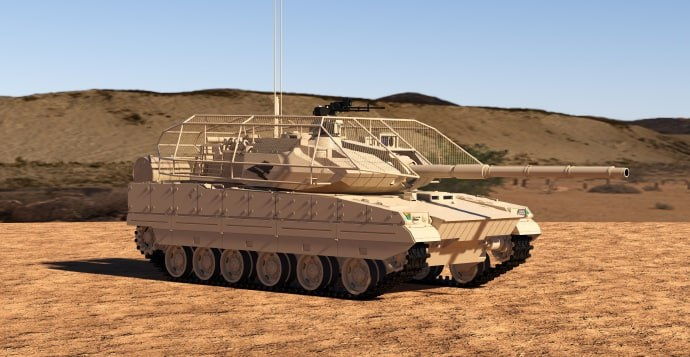In a notable development showcasing China’s evolving battlefield strategies, the Chinese People’s Liberation Army Ground Force (PLAGF) has outfitted its Type 15 tanks with anti-drone cope cages.
Images posted by military observer Jesus Roman on October 7 revealed that China’s Type 15 tanks are now equipped with cope cages for the first time.
These tanks, part of a high-altitude combined arms combat exercise, were seen in China’s Western Theater Command with metal caging installed over their turrets: a move designed to protect against first-person view (FPV) drone attacks.
Roman said that the exercise, conducted at an altitude of 5,300 meters, involved armored units operating in the Western Theater Command, which oversees the vast regions of Xinjiang, Tibet, and the border with India.
The deployment of these tanks with cope cages marks the first public appearance of the Type 15 tanks equipped with this specific counter-drone solution.

The installation of these cope cages reflects China’s proactive stance in addressing the increasing threat posed by drones on modern battlefields.
FPV drones in Ukraine have repeatedly targeted and damaged armored vehicles, tanks, and other fortified military positions, prompting nations like Israel and China to adapt their military strategies.
The installation of these metal screens is part of a larger initiative by the People’s Liberation Army Ground Force (PLAGF) to improve the survivability of its armored units. China also implemented similar counter-drone measures on its ZBD-09 infantry fighting vehicles earlier this year, which were equipped with metal screens atop their turrets.
These developments indicate that the Chinese military is drawing significant lessons from the challenges faced by Russian forces in Ukraine, particularly the vulnerability of armored units to drone strikes.
However, it remains unclear when this military exercise happened, as no specific dates have been provided. Additionally, there is no detailed information on the number of tanks equipped with these anti-drone solutions during the drills.

China’s Type 15 Tank: A Challenge For India In High-Altitude Warfare
The Type 15 tank, or the ZTQ-15, is a highly mobile, lightweight combat vehicle designed for operations in challenging terrains such as high-altitude regions and dense forests.
This versatility makes it an invaluable asset for the Chinese military, particularly in areas like the Line of Actual Control (LAC) with India, where its quick deployment reportedly surprised Indian forces.
“Inspired” by the rapid deployment of Chinese Type-15 tanks, the Indian Army quickly realized the need for lightweight tanks and initiated Project Zorawar. India later showcased the ‘Zorawar’ light battle tank, designed for high-altitude warfare. Jointly developed by the DRDO and L&T, Zorawar has been tailored to meet the Indian Army’s needs to counter Chinese deployments across the LAC.
What sets the Type 15 apart is its exceptional maneuverability on plateaus, where heavier tanks often struggle due to the thinner air and reduced oxygen levels that hinder engine performance.
The Type 15’s lightweight design and powerful engine give it a significant advantage in these conditions, allowing it to outperform heavy tanks.

Its presence in these high-altitude areas presents a serious challenge to Indian forces, as no similar category vehicle in India’s current arsenal matches the agility and firepower of the Type 15 on this difficult terrain.
Weighing around 33 tons, the Type 15 is nearly half the weight of a typical main battle tank (MBT). While its armor is thinner, and it is equipped with a 105-millimeter gun instead of the larger 120- or 125-millimeter cannons found on heavier tanks, this trade-off allows it to excel in regions where heavier tanks falter.
Powered by a 1,000-horsepower diesel engine, the Type 15 can reach a top speed of 70 km/h on roads and has an operational range of 450 kilometers. Additionally, its firepower is enhanced by a remote weapon station featuring a 12.7mm machine gun and a 40mm automatic grenade launcher with a capacity of 38 rounds.
The Type 15’s anti-drone measures further bolster its survivability, particularly in combat scenarios where it may face first-person view (FPV) drones or similar aerial threats.
‘Cope Cage’ On Tanks
Initially viewed as makeshift defenses, the anti-drone cages have evolved into a standard protective measure adopted by military forces worldwide. These cages provide a significant tactical advantage by absorbing drone strikes and reducing the damage inflicted by suicide drones.
The trend of equipping military vehicles with these cages gained momentum in mid-February 2022, when tanks of the Russian Ground Forces, fitted with overhead slate armor, were observed in Belarus shortly before the invasion of Ukraine.
This armor was quickly recognized as a response to counter the Javelin missiles supplied by the United States to Ukraine. The Javelin missiles can be programmed at launch to ascend above a target and then detonate their shaped charge warhead downwards onto a tank’s turret armor, typically the weakest point of the vehicle.
The impact of such attacks can be devastating for tanks. These tanks store a significant portion of 125-millimeter ammunition in the turret, unprotected in a carousel.

Meanwhile, Indian Army tanks have also been seen with cope cages, with the T-90S main battle tanks outfitted with these structures in the past year. Additionally, Israeli tanks have been photographed featuring “cope cages,” which are hastily constructed metal armor designed to detonate anti-tank charges before they can impact the tank.
- Contact the author at ashishmichel(at)gmail.com
- Follow EurAsian Times on Google News




